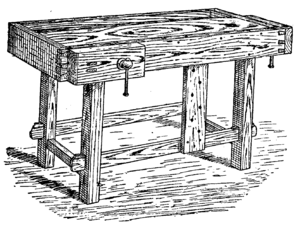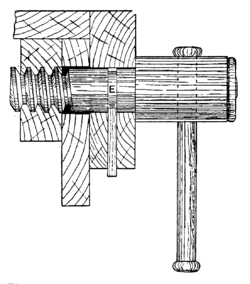receive the stop, which is of the pattern shown by Fig. 32, so that it fits tightly against the leg of the bench. Fig. 26 shows a joiner's bench of another pattern, fitted with a good form of instantaneous grip vice; and another variety of this useful class of vice is shown in section at Fig. 31.
A bench with side and tail vices is illustrated at Fig. 27, and, although not much used by joiners, is a very useful form for small work or as a portable bench. The top and tail vice cheeks contain holes for the reception of bench stops of iron or wood, against which, or between which, work is held for framing, etc.
Bench Screws.—A common form of joiner's bench screw is shown by Fig. 28, inside and sectional views being shown respectively by Figs. 29 and 30. D is the side or cheek of the bench to which a wooden nut (A) is screwed. The box B, which accurately fits the runner shown inside it, is fixed to the top rail connecting the legs, and to the top and side of the bench. Care is taken to keep the runner at right angles to the vice cheeks. To fasten the vice outer cheek and screw together, so that upon turning the latter the former will follow it, a groove E is cut. Then from the under edge of the cheek a mortise is made, and a hardwood key is driven to fit fairly tight into the mortise, its end entering E. The screw cheek is usually about 1 ft. 9 in. long, 9 in. wide, and 2 in. to 3 in. thick. The runner is about 3 in. by 3 in. and 2 ft. long. The wooden screws and nuts can be bought ready made.
Bench screws are known in great variety,





